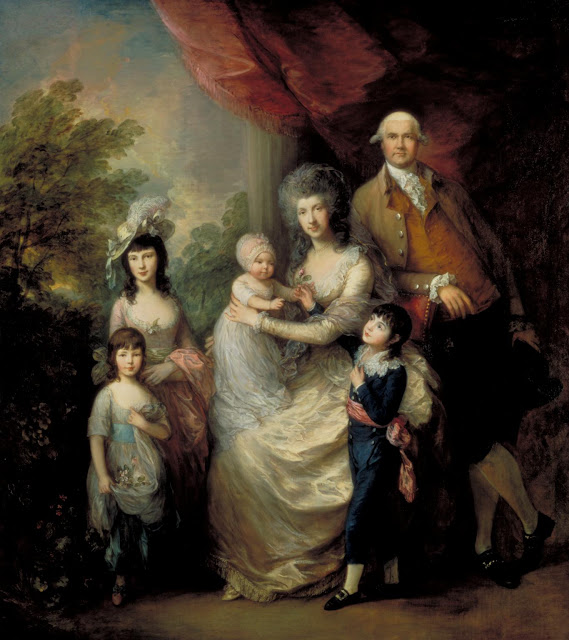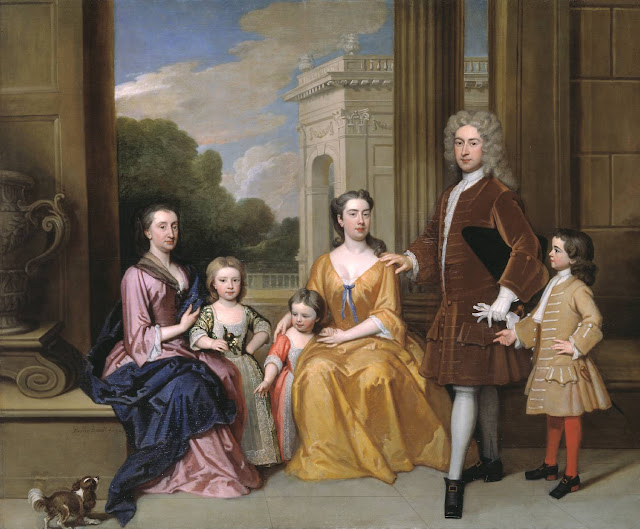 |
| Hugh Barron The Children of George Bond of Ditchleys 1768 oil on canvas Tate Gallery |
"George Bond, the father of the seven children depicted in this portrait, was a wealthy city merchant and an official in the East India Company. The family seems to have occupied several imposing residences, including a country house, 'Ditchleys' in Essex, and a Jacobean mansion in Wimbledon. In the foreground, the three older boys play cricket, flanked by their two sisters. Their two younger brothers are dressed in white frocks, as was then the custom for toddlers of either sex. The youngest boy, Essex Henry Bond, second from the left, later made his career as a commander in the navy, transporting convicts to Australia."
 |
| Joshua Reynolds Sketch for The 4th Duke of Marlborough and his Family ca. 1777 oil on canvas Tate Gallery |
"Reynolds rarely made preliminary sketches even for complex compositions. But the magnificent group of the family of the Duke of Marlborough, which still dominates the Red Drawing Room at Blenheim Palace, was clearly an exception. Conceived in the grandest traditions of Rubens and Van Dyck, it was to influence society portraiture into this century. This sketch shows the painter struggling with the problem of integrating the solemn splendour of the adults with a more modern, relaxed informality preferred for young children and dogs."
 |
| Thomas Gainsborough The Baillie Family ca. 1784 oil on canvas Tate Gallery |
"Group portraits by Gainsborough are relatively rare. This large example shows the London merchant James Baillie with his wife Colin Campbell, and their four young children. Baillie's wife had been given the Christian name of her father Colin Campbell of Glenure. Although a formal portrait, Gainsborough conveys the sense of an affectionate family. Here, Mrs. Baillie is seated roughly in the centre of the composition. Standing her youngest child on her knee, she appears to be the fulcrum of family life."
 |
| Johann Zoffany Portrait Sketch of Thomas Gainsborough ca. 1772 oil on canvas Tate Gallery |
"This study of Thomas Gainsborough was probably made as part of Zoffany's preparations for an elaborate group portrait of members of the new Royal Academy of Arts, which he painted in 1771-72. Gainsborough was one of the Academy's founder members. In spite of this study, Gainsborough was not in fact included in Zoffany's final painting. He disliked the Academy's self-importance and formality, and his absence from Zoffany's picture probably reflects his half-hearted relationship with it."
 |
| Joseph Highmore Mr. Oldham and his Guests ca. 1735-45 oil on canvas Tate Gallery |
"This picture is among the most original works to have been produced in England in the first half of the eighteenth century, maintaining the intimate atmosphere of a small conversation piece in a full-size group portrait. Highmore painted it at the request of Nathaniel Oldham to commemorate a dinner party held at Oldham's home, to which he himself had arrived belatedly. According to the author and antiquarian John Thomas Smith, 'Mr. Oldham had invited three friends to dine with him at his house in Ealing; but being a famous and constant sportsman he did not arrive till they had dined; and then he found them so comfortably seated with their pipes over a bowl of negus, that he commissioned Highmore to paint the scene and desired that he might be introduced in it just as he then appeared.' Mr. Oldham, who has just arrived, stands at the extreme left of the painting, his arms folded over the top of the chair, his tricorn hat still on his head. He wears an expression of barely concealed amusement. In the centre, seated with his pipe and glass of negus, is a large, red-faced man, identified by Smith as a neighbouring farmer. At the right, dressed in black, is a local schoolmaster, his glassy-eyed stare and slumped posture indicating that he has supped well. Between these two figures, peering out over his glass, is the third guest, Joseph Highmore, whom Oldham commissioned to paint the scene."
 |
| William Hogarth Ashley Cowper with his Wife and Daughter 1731 oil on canvas Tate Gallery |
"This portrait was probably begun to mark the marriage of Hogarth's friend Ashley Cowper to Dorothy Oakes in about 1730. Their marriage is referred to through the priestly figure officiating at an altar on the urn behind them, and by the Latin inscription on the pedestal by the poet Virgil. Here, Gallus, a pilgrim in Arcadia, states how he would willingly give up hunting with his hounds in order to be with his beloved shepherdess. Likewise, Cowper turns away from his favourite dog towards his new wife. The child is probably the couple's eldest daughter, Theodora, who was added to the picture at a later date."
 |
| William Hogarth The Strode Family ca. 1738 oil on canvas Tate Gallery |
"Hogarth's early success as a painter was based on his exceptionally lively small-scale 'conversation pieces' or informal group portraits, which became fashionable in the 1730s. They reflected the move away from the solemn formality of the previous generation, and attempted to show the sitters in easy, natural poses, in a domestic setting, engaged in everyday activities. The main subject here is the wealthy city magnate William Strode, seated at table with his new wife Lady Anne Cecil, his relative Col. Strode, and his tutor Dr. Arthur Smyth, later Archbishop of Dublin."
 |
| Francis Hayman Samuel Richardson seated surrounded by his Second Family 1740-41 oil on canvas Tate Gallery |
"Samuel Richardson was one of the earliest practitioners of the novel. He came to public attention with Pamela, or, Virtue Rewarded of 1740 which tells the story of an upright young maidservant and the lustful attentions of her master whom she constantly rebuffs, then reforms, and finally marries."
 |
| Godfrey Kneller Portrait of the Harvey Family 1721 oil on canvas Tate Gallery |
"This painting shows the Harvey family of Rolls Park, Essex. Their wealth was built on business, but the scale and format of this picture imitates the aristocratic style of grand courtly portraiture."
 |
| Joseph van Aken An English Family at Tea ca. 1720 oil on canvas Tate Gallery |
"This group portrait of an unidentified family and their servants was probably painted soon after Van Aken moved from his native Antwerp to London. Tea was an expensive commodity, as were all the items related to its consumption: the tea table, silver, and porcelain. The tea box is shown in the foreground. Its contents were normally kept locked by the lady of the household, who is shown dispensing the precious leaves from a container. Demonstrating wealth, domesticity and genteel informality, tea-drinking came to epitomise civilised behaviour in the eighteenth century."
 |
| Johan Zoffany Mr and Mrs Dalton and their Niece, Mary de Heulle ca. 1765-68 oil on canvas Tate Gallery |
"The sitters are Richard Dalton, antiquarian and minor graphic artist, librarian to George III and from 1778 surveyor of the King's pictures; his wife Esther (née de Heulle) whom he married in 1764; and their niece Mary de Heulle, the daughter of Esther's brother Abraham and his wife Mary Magdalen Garnault. Their orphaned child was adopted by the Daltons, who were themselves childless. She received £633,000 in trust from her grandfather, Abraham de Heulle, a wealthy Huguenot Spitalfields silk-weaver, on his death in 1765, and was a legatee in her aunt's will of 1775. The young Mary is beginning a drawing under Dalton's instruction."
 |
| Francis Cotes Anna Maria Astley aged seven and her brother Edward aged five and a half 1767 oil on canvas Tate Gallery |
"The children in this portrait were the offspring of wealthy baronet and landowner Sir Edward Astley and his second wife Anne Milles. They are depicted at play on a classical terrace reminiscent of the family's grand estate at Melton Constable, Norfolk. Anna Maria, who waves her brother's plumed hat above her head, died in childhood, the year after this portrait was painted. Edward, whose elder brother was to inherit his father's title, lived to carve out a successful career as a soldier in the British army. It is thought that the portrait was commissioned by the children's maternal grandfather."
 |
| John Hamilton Mortimer George Thompson, his Wife, and a Visitor ca. 1766-68 oil on canvas Tate Gallery |
"The group shows Lt. Col. George Thompson and his wife, who have been reading the collected works of the satirical poet Charles Churchill. A lady visitor, carrying her reticule and flowers, interrupts their slippered ease. From the casual gesture with which Thompson motions her towards a chair, one can assume that she is a close relation."
 |
| Francis Wheatley A Family Group in a Landscape ca. 1775 oil on canvas Tate Gallery |
"Wheatley's portrait, which seeks to evoke an atmosphere of domestic harmony, depicts a prosperous family in a pastoral landscape. While the two elder sons prepare to fly their kite, the infant son, still dressed in a customary frock, clings to his mother to avoid the unwanted attentions of the family dog. At the centre the standing father strikes a suitably patriarchal pose. Less harmonious is the presence of the young black servant in shadow at the extreme left. Silhouetted against the sky, his physical detachment from the main group emphasises the fact of the time, that he belongs to the group only in the sense that he is a family possession."